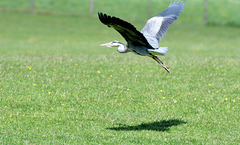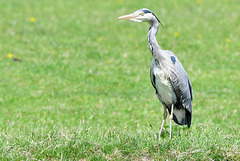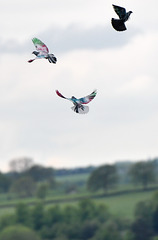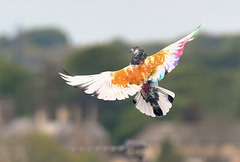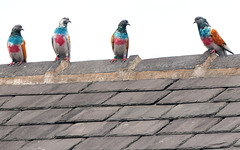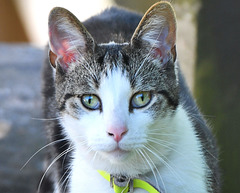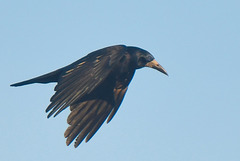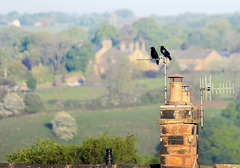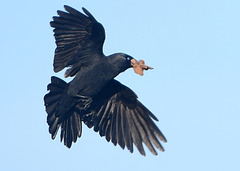Phil's photos
Eco Drive.
| |
|
|
|
A close-up test using a non-macro lens....it took many attempts before I managed to get a good shot without too many reflections. I don't know if this will really "run forever" (as claimed by Argos) but it will probably outlive me.....it has already outlived three watch-straps :-)
"A simple yet revolutionary concept: a watch that never needs a battery. Citizen Eco-Drive technology harnesses the power of light from any natural or artificial light source and converts it into energy which is stored in a permanently rechargeable lithium-ion cell. It recharges continuously in any kind of light to run forever."
(Argos advertisement).
www.argos.co.uk/product/9157332
Camera: Nikon D500
Lens: AF-S DX Zoom-Nikkor 17-55mm f/2.8G IF-ED
Software: Nikon Capture NX2
Male Blackbird (Turdus merula).
| |
|
|
|
A familiar thrush, the melodious blackbird is a common sight in gardens, parks and woodlands across the UK. Blackbirds are especially fond of feeding on lawns and can be seen with their heads cocked to one side, listening for earthworms. Male blackbirds are unmistakable - they are entirely black, with a yellow bill and yellow ring around the eye. Females are dark brown, with streaking on the chest and throat. Juveniles are also dark brown, but covered with gingery streaks.
(The Wildlife Trusts).
Camera: Nikon D500
Lens: AF-S VR Zoom-Nikkor 70-300mm f/4.5-5.6G IF-ED
Software: Nikon Capture NX2
Shades of green.
| |
|
|
|
Photographed along the Reedley Hallows Greenway trail near the town of Reedley in Lancashire, North-West England.
Camera: Nikon D500
Lens: AF-S Nikkor 70-200mm f/2.8G ED VR II
Software: Nikon Capture NX2
Grey heron (3 of 3).
| |
|
|
|
The grey heron (Ardea cinerea) is a long-legged predatory wading bird of the heron family, Ardeidae, native throughout temperate Europe and Asia and parts of Africa. It is resident in much of its range but some populations from the more Northern parts migrate southwards in autumn. A bird of wetland areas, it can be seen around lakes, rivers, ponds, marshes and on the sea coast. It feeds mostly on aquatic creatures which it catches after standing stationary beside or in the water or stalking its prey through the shallows. Standing up to 1 m tall, adults weigh from 1 to 2 kg (2.2 to 4.4 lb). They have a white head and neck with a broad black stripe that extends from the eye to the black crest. The body and wings are grey above and the underparts are greyish-white, with some black on the flanks. The long, sharply pointed beak is pinkish-yellow and the legs are brown.
(Wikipedia).
Camera: Nikon D500
Lens: AF-S Nikkor 70-200mm f/2.8G ED VR II
Software: Nikon Capture NX2
Grey heron (2 of 3).
| |
|
|
|
The grey heron (Ardea cinerea) is a long-legged predatory wading bird of the heron family, Ardeidae, native throughout temperate Europe and Asia and parts of Africa. It is resident in much of its range but some populations from the more Northern parts migrate southwards in autumn. A bird of wetland areas, it can be seen around lakes, rivers, ponds, marshes and on the sea coast. It feeds mostly on aquatic creatures which it catches after standing stationary beside or in the water or stalking its prey through the shallows. Standing up to 1 m tall, adults weigh from 1 to 2 kg (2.2 to 4.4 lb). They have a white head and neck with a broad black stripe that extends from the eye to the black crest. The body and wings are grey above and the underparts are greyish-white, with some black on the flanks. The long, sharply pointed beak is pinkish-yellow and the legs are brown.
(Wikipedia).
Camera: Nikon D500
Lens: AF-S Nikkor 70-200mm f/2.8G ED VR II
Software: Nikon Capture NX2
Grey heron (Ardea cinerea).
| |
|
|
|
The grey heron (Ardea cinerea) is a long-legged predatory wading bird of the heron family, Ardeidae, native throughout temperate Europe and Asia and parts of Africa. It is resident in much of its range but some populations from the more Northern parts migrate southwards in autumn. A bird of wetland areas, it can be seen around lakes, rivers, ponds, marshes and on the sea coast. It feeds mostly on aquatic creatures which it catches after standing stationary beside or in the water or stalking its prey through the shallows. Standing up to 1 m tall, adults weigh from 1 to 2 kg (2.2 to 4.4 lb). They have a white head and neck with a broad black stripe that extends from the eye to the black crest. The body and wings are grey above and the underparts are greyish-white, with some black on the flanks. The long, sharply pointed beak is pinkish-yellow and the legs are brown.
(Wikipedia).
Camera: Nikon D500
Lens: AF-S Nikkor 70-200mm f/2.8G ED VR II
Software: Nikon Capture NX2
Black-headed gull (Larus ridibundus).
| |
|
|
|
This gull is 38–44 cm (15–17 in) long with a 94–105 cm (37–41 in) wingspan. The summer adult has a chocolate-brown head (not black, although does look black from a distance), pale grey body, black tips to the primary wing feathers and a red bill and legs. The hood is lost in winter leaving just 2 dark spots. Immature birds have a mottled pattern of brown spots over most of the body. It breeds in colonies in large reed beds or marshes, or on islands in lakes, nesting on the ground. Like most gulls it is highly gregarious in winter both when feeding or in evening roosts. The black-headed gull is a bold and opportunistic feeder. It eats insects, fish, seeds, worms, scraps and carrion in towns or invertebrates in ploughed fields with equal relish. It is a noisy species, especially in colonies, with a familiar "kree-ar" call. Its scientific name means laughing gull. It can be found over much of Europe except Spain, Italy and Greece. It is also found in Japan and Eastern China. It is an occasional visitor to the east coast of North America.
(Wikipedia).
Camera: Nikon D500
Lens: AF-S Nikkor 70-200mm f/2.8G ED VR II
Software: Nikon Capture NX2
Born to be wild?
| |
|
|
|
I wonder if this man's name is Heath Robinson? UK viewers will "get" the joke but for those who are not familiar with the name and reference, please see below.
William Heath Robinson (1872 – 1944) was an English cartoonist, illustrator and artist, best known for drawings of whimsically elaborate machines to achieve simple objectives. In the UK the term "Heath Robinson" entered the popular language during the 1914–1918 World War as a description of any unnecessarily complex and implausible contrivance, much as "Rube Goldberg machines" came to be used in the United States from the 1920s onwards as a term for similar efforts. "Heath Robinson contraption" is perhaps more often used in relation to temporary fixes using ingenuity and whatever is to hand, often string and tape or unlikely cannibalisations. Its continuing popularity was undoubtedly linked to Britain's shortages and the need to "make do and mend" during the Second World War.
(Wikipedia).
Camera: Nikon D500
Lens: AF-S Nikkor 70-200mm f/2.8G ED VR II
Software: Nikon Capture NX2
Title "borrowed" from here:
www.youtube.com/watch?v=egMWlD3fLJ8
Candid.
| |
|
|
|
I saw this old man with the young boy standing in the entrance to a garage across the street so I grabbed a quick "candid" shot with my new camera to see how it performs with portraiture. I'm very pleased with the result....much better than I expected from a quick snapshot.
Camera: Nikon D500
Lens: AF-S Nikkor 70-200mm f/2.8G ED VR II
Software: Nikon Capture NX2
Painted pigeons (3 of 3).
| |
|
|
|
Camera: Nikon D500
Lens: AF-S Nikkor 70-200mm f/2.8G ED VR II
Software: Nikon Capture NX2
Painted pigeons (2 of 3).
| |
|
|
|
Camera: Nikon D500
Lens: AF-S Nikkor 70-200mm f/2.8G ED VR II
Software: Nikon Capture NX2
Painted pigeons (1 of 3).
| |
|
|
|
These pigeons are regular visitors to my locality....I assume they're racing birds and that the colours are to enable their owner to identify them whilst in flight (they also each have a green ring on their leg).
Camera: Nikon D500
Lens: AF-S Nikkor 70-200mm f/2.8G ED VR II
Software: Nikon Capture NX2
Eye contact.
| |
|
|
|
My neighbour's cat. Usually she is quite timid and runs away when strangers come close but this time she seemed quite happy to sit and pose for about ten minutes until she got bored.
Camera: Nikon D500
Lens: AF-S Nikkor 70-200mm f/2.8G ED VR II
Software: Nikon Capture NX2
Mallards in flight.
| |
|
|
|
Two male mallards in flight....they were following a female but I couldn't get them all in the frame at the same time as she was too far in front.
Camera: Nikon D500
Lens: AF-S Nikkor 70-200mm f/2.8G ED VR II
Software: Nikon Capture NX2
Rook (Corvus frugilegus).
| |
|
|
|
The rook (Corvus frugilegus) is a member of the family Corvidae in the passerine order of birds. It was given its binomial name by Carl Linnaeus in 1758. The binomial is from Latin; Corvus for "raven" and frugilegus is Latin for "fruit-gathering" from frux, "fruit" and legere, "to pick". The English name is ultimately derived from the bird's harsh call. Rooks are distinguished from similar members of the crow family by the bare grey-white skin around the base of the adult's bill in front of the eyes. The feathering around the legs also looks shaggier and laxer than the carrion crow. The juvenile is superficially more similar to the crow because it lacks the bare patch at the base of the bill but it has a thinner bill and loses the facial feathers after about six months.
(Wikipedia).
Camera: Nikon D500
Lens: AF-S Nikkor 70-200mm f/2.8G ED VR II
Software: Nikon Capture NX2
By the dawn's early light.
| |
|
|
|
A couple of early-risers practising their dawn chorus, photographed just after sunrise this morning. No prizes for guessing where the title came from :-)
Camera: Nikon D500
Lens: AF-S Nikkor 70-200mm f/2.8G ED VR II
Software: Nikon Capture NX2
Fast food.
| |
|
|
|
A jackdaw carrying what appears to be a slice of brown bread back to it's nest on nearby buildings. The bird was about 30 metres / 33 yards from my shooting position according to the EXIF information so I had to crop the photo quite a lot to get a reasonably large image with my 200mm lens, therefore the resolution is not quite perfect. I used "continuous high speed" (10 frames per second) shooting mode and "continuous auto-focus" with an exposure compensation of +1.7 to avoid the bird becoming a silhouette against the bright blue sky.
Camera: Nikon D500
Lens: AF-S Nikkor 70-200mm f/2.8G ED VR II
Software: Nikon Capture NX2
Pendle Hill.
| |
|
|
|
Pendle Hill photographed from a distance of about 4 miles / 6.5 Kilometres (cropped to remove uninteresting foreground). My "shooting" location was near the town of Reedley which is South-East of the hill.
Pendle Hill is famous for its links to three events which took place in the 17th century: the Pendle witch trials (1612), Richard Towneley's barometer experiment (1661), and the visitation by George Fox (1652), which led to the foundation of the Quaker movement. A Bronze Age burial site has also been discovered at the summit of the hill.
(Wikipedia).
Camera: Nikon D500
Lens: AF-S DX Zoom-Nikkor 17-55mm f/2.8G IF-ED
Software: Nikon Capture NX2




